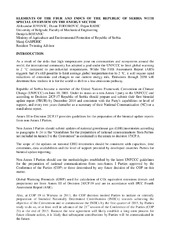Приказ основних података о документу
Elements of the FBUR and INDCs of the Republic of Serbia with special overview on the energy sector
| dc.creator | Jovović, Aleksandar | |
| dc.creator | Todorović, Dušan | |
| dc.creator | Radić, Dejan | |
| dc.creator | Božanić, Danijela | |
| dc.creator | Gasperič, Matej | |
| dc.date.accessioned | 2023-03-10T16:54:08Z | |
| dc.date.available | 2023-03-10T16:54:08Z | |
| dc.date.issued | 2015 | |
| dc.identifier.isbn | 978-86-7877-025-8 | |
| dc.identifier.uri | https://machinery.mas.bg.ac.rs/handle/123456789/5657 | |
| dc.description.abstract | The Republic of Serbia became a member of the United Nations Framework Convention on Climate Change (UNFCCC) on June 10, 2001. Under its status as a non-Annex I party to the UNFCCC and according to Decision 2/CP.17 Republic of Serbia should prepare and submit its first biennial update report (FBUR) every two years thereafter as a summary of their National Communications (NC) or a stand-alone report. Also, the Conference of Parties (COP) in Warsaw invited Parties to initiate or intensify the preparation of Intended Nationally Determined Contributions (INDCs) toward achieving the objective of the Convention. The GHG inventory for the Republic of Serbia was prepared according to the 2006 IPCC Guidelines, employing the Tier 1 Method for all inventoried years, i.e. 1990, as the base year, and the years 2010-2013. Total GHG emissions in 2013 decreased by 3.5% in comparison to 2010. Also, according to three possible scenarios („basic‟, „with measures‟ and „with additional measures‟ scenario), aggregated GHG emission trend and projection in the period 1990-2030 was prepared. It could be concluded that departure from the „basic‟ scenario in the „with measures‟ scenario equals 11 and 14 percent in 2020 and 2030, respectively, and in the „with additional measures‟ scenario departure from the „basic‟ scenario equals 18 and 22 percent in 2020 and 2030, respectively. The setting of the new target values, such as GHG emissions in 2020 and 2030 that are lower by 4.9% and 4.3% („basic‟) or 15.0% and 9.8% („with measures‟ scenario) compared to 1990 respectively, significantly indicates the determination of the RS in the fight against climate change. Moreover, by joining the EU in the expected period (2020/2021), the EU climate policy, including the EU Emissions Trading Scheme (EU ETS), will be fully implemented, while emissions could be additionally reduced. However, this still remains an ambitious goal for a country like the RS, which is still considered a developing country under the UNFCCC. | sr |
| dc.language.iso | en | sr |
| dc.publisher | Beograd : Društvo termičara Srbije | sr |
| dc.rights | openAccess | sr |
| dc.rights.uri | https://creativecommons.org/licenses/by-nc-nd/4.0/ | |
| dc.source | Proceedings of Fifth Regional Conference Industrial Energy and Environmental Protection in South Eastern European Countries (IEEP), 2015, 001.1-001.9 | sr |
| dc.subject | UNFCCC | sr |
| dc.subject | GHG | sr |
| dc.subject | Energy | sr |
| dc.subject | FBUR | sr |
| dc.subject | INDCs | sr |
| dc.title | Elements of the FBUR and INDCs of the Republic of Serbia with special overview on the energy sector | sr |
| dc.type | conferenceObject | sr |
| dc.rights.license | BY-NC-ND | sr |
| dc.citation.epage | 001.9 | |
| dc.citation.rank | M33 | |
| dc.citation.spage | 001.1 | |
| dc.identifier.fulltext | http://machinery.mas.bg.ac.rs/bitstream/id/13930/bitstream_13930.pdf | |
| dc.identifier.rcub | https://hdl.handle.net/21.15107/rcub_machinery_5657 | |
| dc.type.version | publishedVersion | sr |


